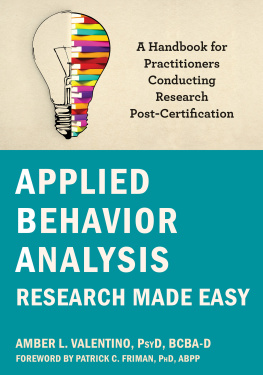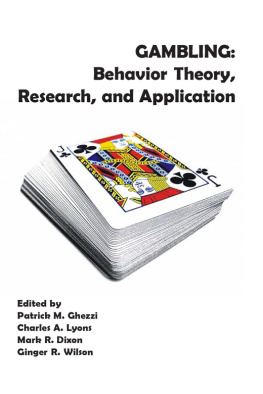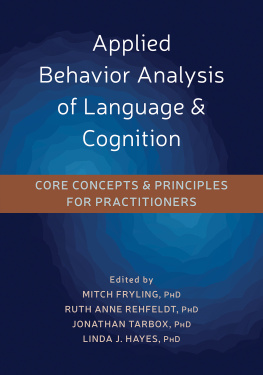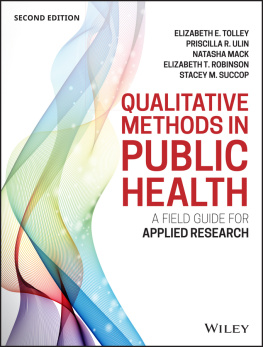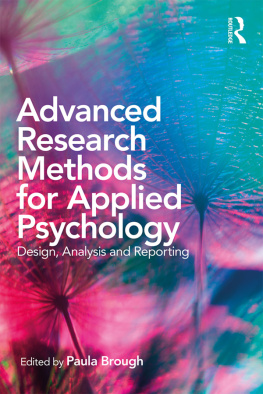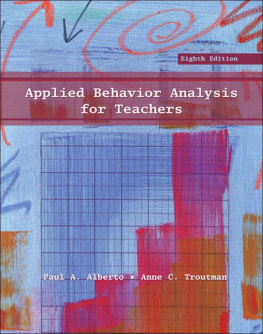A long-overdue resource that is going to be useful for just about any practitioner who cares about science.
Jonathan Tarbox, PhD, BCBA , director of the master of science in applied behavior analysis (ABA) program at the University of Southern California, as well as director of research at FirstSteps for Kids
Amber Valentino has taken the very best of her expertise and experiences and combined it with practical, accessible information to empower ANY post-certification practitioner to conduct applied research. I could almost hear Valentinos voice in my head while I read her book telling me, Sarah! You can do applied research! Lets go! I look forward to what will hopefully be an outrageous increase in applied research studies and publications as a result of practitioners using Valentinos book!
Sarah Trautman, MA, BCBA , cofounder of defy Community, and Amber Valentinos biggest fan
Research can seem daunting in clinical settings where opportunities and resources may be limited; however, practitioners are in a unique position to conduct socially significant research. Valentino provides practical recommendations, exercises, and examples to help develop research repertoires of practitioners. This book may give you confidence to integrate research into practiceenhancing clinical work, improving outcomes for clients, and pushing the field toward a better understanding of behavior.
Jessica Juanico, PhD, BCBA-D , assistant professor of practice, and assistant director of online programs of applied behavioral science at the University of Kansas
Valentino makes transparent the spot-on, effective strategies she has used to publish clinical work. I love the conversational style and engaging workbook format of the book, as well as the provided examples. This will be required reading for students in my lab to guide their research projects, because it fills a huge void of behavior analytic texts that support clinicians who want to become a published scientist practitioner.
Stephanie M. Peterson, PhD, BCBA-D, LBA , professor of psychology and associate dean of the college of arts and sciences at Western Michigan University, and editor of Behavior Analysis in Practice
In this book, Valentino presents a straightforward, tried-and-true formula for conducing applied research and closing the research-to-practice gap. It is a must-read for any applied researcher, especially those looking to breakout into the research space.
Matthew T. Brodhead, PhD, BCBA-D , associate professor at Michigan State University
As a field, we would greatly benefit from more practicing behavior analysts producing research, but there are very real barriers to doing so. Valentino understands these barriers firsthand, and knows how to overcome them. This handbook is a great how-to guide with activities and worksheets that meet the reader wherever their needs are in starting to produce research. Youll be learning from one of the best with this book!
Daniel Conine, PhD, BCBA-D , assistant professor at Georgia State University
I had the honor to be mentored by Amber Valentino during my postdoctoral fellowship a few years ago. This book is the book of wisdom all postgraduates have been waiting for. Valentino provides a detailed overview of how to design, implement, and publish research with extensive examples that is a breath of fresh air for all practitioners.
Angelica A. Aguirre, PhD, BCBA-D , assistant professor at Minnesota State University, Mankato
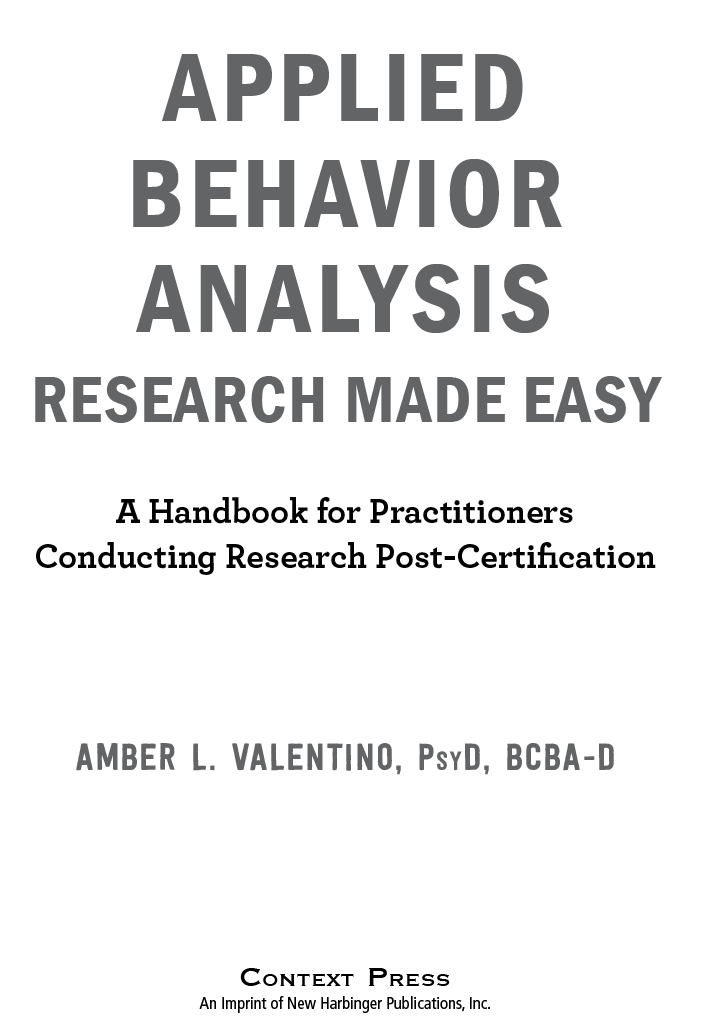
Publishers Note
This publication is designed to provide accurate and authoritative information in regard to the subject matter covered. It is sold with the understanding that the publisher is not engaged in rendering psychological, financial, legal, or other professional services. If expert assistance or counseling is needed, the services of a competent professional should be sought.
Distributed in Canada by Raincoast Books
NEW HARBINGER PUBLICATIONS is a registered trademark of New Harbinger Publications, Inc.
Copyright 2021 by Amber L. Valentino
Context Press
An imprint of New Harbinger Publications, Inc.
5674 Shattuck Avenue
Oakland, CA 94609
www.newharbinger.com
Cover design by Amy Shoup; Acquired by Ryan Buresh; Edited by Rona Bernstein; Indexed by James Minkin
All Rights Reserved
Library of Congress Cataloging-in-Publication Data
Names: Valentino, Amber, author.
Title: Applied behavior analysis research made easy : a handbook for practitioners conducting research post-certification / by Amber L. Valentino, Psy.D., BCBA-D.
Description: Oakland, CA : New Harbinger Publications, [2021] | Includes bibliographical references and index.
Identifiers: LCCN 2021031169 | ISBN 9781684037827 (trade paperback)
Subjects: LCSH: Psychology, Applied--Research. | Behavior analysts.
Classification: LCC BF636 .V34 2021 | DDC 158.1--dc23
LC record available at https://lccn.loc.gov/2021031169
For my husband, Garth, and my son, Porter
Contents
Foreword
The science and practice of behavior analysis is enjoying a heyday, possibly a zeitgeist, or, more modestly, it is coming into its own. For years it was a tiny portion of the vast behavioral and psychological science and practice community. With the rise in the prevalence of autism and the research-verified treatment methods for its symptoms, along with a collection of research-verified treatments for a variety of other mental and behavioral health concerns, its portion of that community has expanded significantly. For a supportive example of what I assert, merely enter applied behavior analysis into the search window of the book section of Amazon.com. There are countless books on the science and practice of behavior analysis. However, if one were to search for books explaining how to conduct behavior analytic research and get it published, the search would narrow down to few options. Although these are helpful, they are not as complete nor as uniformly helpful to junior investigators as the book for which this is a foreword.
When I was a graduate student, a dog-eared manual on how to conduct and publish applied behavior analytic research circulated in the department of Human Development and Family Life (HDFL) at the University of Kansas, authored by L. Keith Miller. At that time it was the only book-level resource available that could lead the novice investigator through the publication process. All graduate students in the HDFL department treasured their copy. I certainly treasured mine, although in preparation for writing this foreword, a search of my entire library revealed that my copy has walked off. This is no surprise to me. I have been training behaviorally oriented psychology interns for more than thirty years, and many, probably most, of them have been interested in publishing in behavior analytic journals. Having mastered the process myself, I had no need to consult Keith Millers guidebook. I suspect one of the former interns borrowed it and now, due to the amnesia that often accompanies borrowed books, they own it (whoever they are). They very likely cherished it and consulted it with vigor as they proceeded with their dissertations or other research projects just as I did back in graduate school. Which brings me to the current offering.
I love this book and wish I would have had it way back in the day, with apologies to Keith Miller. His book was very much a book of its time and indeed was incredibly useful, but the current offering is far more thorough and more directly relevant to the junior investigator. However, I do quibble with the title ever so slightly. I would substitute the word simple for easy because applied behavior analysis research is not easy. People often mistakenly think simple and easy are synonyms, and they are not. What a heroin addict should do is simple. But its pretty darn far from easy. What this book has done is simplify the process of doing behavior analytic research and getting it published. It is unlikely to ever be easyfor anyone. Having said that, I assert that simplifying it does indeed make it easier. And that is a goal that is particularly important for at least three groups of potential consumers: behavior analytic clinicians, behavior analytic students who are in graduate programs that do not supply a complete course on single-subject research design, and non-behavior analytic investigators who would like to conduct single-subject research. This is not to say the book would not be of significant value for seasoned behavior analytic investigators. Having a document that answers virtually every conceivable technical question about publishing applied behavior analytic research at ones fingertips is always a blessing, regardless of ones publishing history. But increasing the publication success of any or all three of these groups serves a larger purpose, specifically the dissemination of the behavior analytic worldview (i.e., the environment is the primary determinant of behavior).

